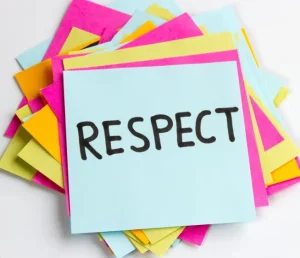Respect is a vital part of the learning environment in the classroom. Respect is a feeling of concern for the well-being of another person, which can be exhibited by courteous behavior and kindness.
It is defined as a genuine admiration for someone, or something based on their traits, abilities, or accomplishments. Simply put, respect is the regard we have for other people, and it shows in our answers to them and our intentions and thoughts for them.
What constitutes Respect in Class
What is two-way respect? In the classroom, mutual respect extends beyond the interactions between students and the teacher. In a climate of two-way respect, students are expected to treat one another with respect.
As a result, more learning occurs in the classroom because children feel comfortable, motivated, and, of course, respected. It constitutes an appropriate teacher-student relationship that is based on respect.
It takes a lot of effort from both the teacher and the students to create this culture. The good news is that students will usually want to keep a positive classroom atmosphere after establishing the culture.
What does Respect in the Classroom Look Like?
While respect standards vary depending on the individual and environment, five simple classroom behaviors can help to define respect in the classroom. These include:
1. Adherence to the rules
One of the most fundamental and crucial habits for fostering respect in the classroom is adhering to the rules.

When students follow the rules, it exhibits a high level of discipline and admiration for the class and its occupants.
It also reinforces behaviors and mannerisms that promote high levels of respect and will benefit learners as they continue through their education.
Almost every student will struggle to follow the rules occasionally.
However, persistent rule-breaking can reflect a fundamental misunderstanding of classroom respect and necessitate educator involvement.
2. Paying attention when peers or teachers speak
Respect in the classroom is demonstrated by listening quietly and attentively to someone speaking.
Whether a teacher is delivering a lesson, a student is sharing a report or project, or a classroom visitor such as administrators or special guests is speaking, refraining from excessive chatter, movement, or other distractions creates a respectful environment that is conducive to growth and learning.
3. Demonstrating consideration for others and kindness
For a reason, treating others as you would like to be treated is the gold standard of respect. Learners must be taught to be polite and considerate to their classmates, teachers, and administrators to cultivate classroom respect.
Maintaining high standards for classroom compassion is also essential for creating a welcoming and inclusive atmosphere for all learners.
With more than half of middle and high school goers reporting feeling unsafe at school, compassion and consideration are more vital than ever in ensuring fair and accessible access to learning opportunities.
4. Patience and self-control
Controlling disruptive tendencies that detract from the learning experience is another hallmark of a respectful classroom.
For instance, in a low-respect classroom, numerous learners may speak without raising their hands during class debates or refuse to wait their turn during school activities or leisure.
Both actions show a lack of self-control and patience, which are essential characteristics for success inside and beyond the classroom.
These behaviors are also linked to rule-following, so a youngster who has trouble adhering to established classroom norms is more likely to have challenges managing distracting or disruptive impulses during class and recess.
5. A promise to be honest
Simply told, respect necessitates honesty. Trust is the foundation of positive student-teacher interactions, and honesty is the foundation of trust.
Educators must demonstrate a personal commitment to honesty and fairness to encourage honesty in the classroom.
They should show their students the benefits of honesty regularly to promote its relevance, even when a student is confessing to something upsetting.
6. Communicate respectfully
Use kind words when talking to your students or teachers. For students, learn how to address your teacher respectfully using the right words.
How Students show Respect in the Classroom
There are simple ways students can show respect in the classroom, including:
1. Listen and be present

Give someone else the courtesy of listening to and considering what they have said before responding, establishing their own opinions, or discarding theirs.
It is acceptable and sometimes necessary for a student to disagree with what is being said.
Yet, they should wait their turn, pay attention, and avoid leaping to conclusions.
2. Be considerate to others’ feelings
Students should note that nobody likes to be embarrassed. So they should learn to be considerate of others’ feelings and opinions.
They should do everything they can to prevent others from feeling the same way. The teacher can also help a student who may feel enraged, upset, or embarrassed if someone rolled their eyes at one of her ideas or spoke over her when she was trying to speak.
3. Addressing mistakes with kindness
Everyone makes mistakes. The instructor and other students should avoid humiliating someone who makes a blunder.
The teacher can take the student aside, gently inform her of her error, and then assist and guide her to improve. We are all human, and we will all require assistance at some point.
It is just the right thing to do to assist others in learning from their mistakes in a dignified manner.
4. Respect for physical boundaries
Everybody has the right to choose how much and what kind of physical touch they want. A student should learn to respect others’ preferences, and how they should insist on others respecting their boundaries.
5. Saying thank you and acknowledging others
It only takes a few seconds to let others know that their efforts are appreciated and to thank them for their time, effort, or thoughtfulness, but it makes a difference.
6. Wear Decently
There is a line that says, the way you dress informs how people will address you. That is the way it goes with respect. If you are an instructor, wear decently as a teacher. The same is true for students.
How to Earn Respect in Class from Others
In school, in class, and later in life, it is essential to know how to earn the respect of your peers. Being respected comes in handy in diverse situations ranging from group projects to dealing with wildfire rumors. To Earn Respect from others:
1. Be confident
Confidence is vital if you want to earn the respect of your peers. Students seldom respect a meek, shy peer in the back of the class.

While there is nothing wrong with having a shy personality, you should aim to be confident if you demand respect.
You have to project confidence when you ask and answer questions in class or when you assert your opinions.
This will show peers that you mean business. That said, confidence should not be confused with arrogance, which will not help you earn respect.
2. Be well-informed
It is difficult to respect ignorant people. To earn respect, you have got to “know your stuff” and prove that you are well-informed.
Your peer will step back and reevaluate you when you can support your opinions with facts and examples from current or historical events. Once they can form a clearer picture of you, they are bound to respect you!
3. Honor your promises
When you give your word, people expect you to keep it. But, as the demand for good character and nobility lessens in modern society, so does the tendency for people to honor their promises.
Yet, students who have respect in class and school are expected to keep their promises. So, to gain the respect of your peers, you must first learn to honor your commitments.
4. Be tolerant
Tolerance is increasingly critical in our society, where different cultures mix and mash together everywhere! Respectable people must be tolerant of others, especially in school. No one will want to respect you unless you are also tolerant of others.
5. Follow the golden rule
If you desire to earn the respect of your peers, you must follow the rule – treat others the way you want to be treated. When you treat others with the dignity and courtesy they deserve, they will most likely return it to you.

